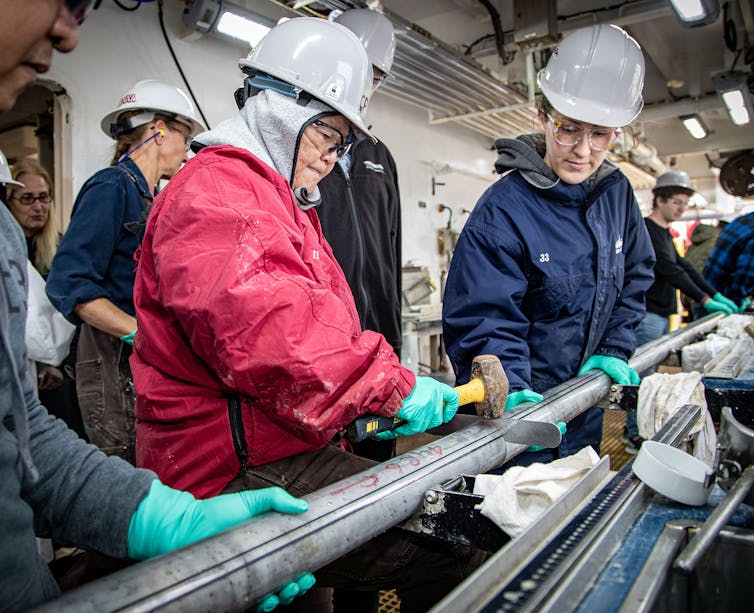
- NASA’s Perseverance rover found a rock, nicknamed Cheyava Falls, with distinctive “leopard spots” on it. The spots are small, irregular and whitish with black edges. The rock is in an ancient Martian riverbed in Jezero crater.
- The rock shows chemical signatures and structures that could have been produced by microbial life billions of years ago. Besides the spots, the signatures and structures include organic compounds and mineral veins, indicating past interaction with water.
- The samples collected by Perseverance highlight the need for the Mars Sample Return Program. This mission, still in the planning stages, would return rock samples, including this one, to Earth for further analysis.
Evidence of life on Mars?
NASA’s Perseverance rover recently came across a rock that “possesses qualities that fit the definition of a possible indicator of ancient life.” Wait, what? The arrowhead-shaped rock, nicknamed Cheyava Falls, is in an ancient riverbed the rover has been exploring. The river once fed into a lake in Jezero crater billions of years ago. As NASA said on July 25, 2024, the rock contains chemical signatures and structures that could have been made by microscopic life. This includes intriguing little white spots with black edges that the mission team calls “leopard spots.” Could they be evidence for ancient life on Mars?
This isn’t proof of past life on Mars, not yet, anyway. But scientists are excited about the discovery.
Our @NASAPersevere Mars rover has found an interesting rock that could be one of the best signs yet that ancient microbial life may have once existed on the Red Planet. However, we'll need to do more research to know for sure: https://t.co/tWpQD6Rcg6 pic.twitter.com/wOfA62VYQo
— NASA (@NASA) July 25, 2024
Look closely ?
These “leopard spots” on a Martian rock are clues pointing to possibly the best signs of ancient microbial life we’ve found yet on Mars. To know for sure, we need to study the rock in labs on Earth.
More on @NASAPersevere's findings: https://t.co/Bo7eiUdGnA pic.twitter.com/0UM4TtM0m0
— NASA JPL (@NASAJPL) July 25, 2024
An intriguing Mars rock
Perseverance found Cheyava Falls along the northern edge of Neretva Vallis, an ancient river valley. The river valley measures about 1,300 feet (400 meters) wide. Mission scientists had planned the route through Neretva Vallis so the rover could visit the most interesting locations.
Nicola Fox is associate administrator, Science Mission Directorate at NASA Headquarters in Washington, D.C. She said:
We have designed the route for Perseverance to ensure that it goes to areas with the potential for interesting scientific samples. This trip through the Neretva Vallis riverbed paid off as we found something we’ve never seen before, which will give our scientists so much to study.
Perseverance used its SHERLOC (Scanning Habitable Environments with Raman & Luminescence for Organics & Chemicals) instrument to analyze the rock. The rover also collected a sample from the rock on July 22, 2024, the 22nd one so far. And, like previous samples, it is being stored in a metal tube for return to Earth at a later date.

Mineral veins, water and organics
Why is this rock so interesting? There are several reasons. First, like many other rocks seen by the rovers, this one is filled with calcium sulfate mineral veins. That is evidence the rock once interacted with water.
In addition, it also contains organic compounds. Those are carbon-based molecules that are the building block of life on Earth. By themselves, they don’t prove the existence of life, since they can also form without life. But the surrounding context and other details can be suggestive as to whether life – as in microbes – was involved or not. That’s why this rock is so special. It is suggestive of possible past microbial life.
Ken Farley, Perseverance project scientist at Caltech in Pasadena, California, said:
Cheyava Falls is the most puzzling, complex and potentially important rock yet investigated by Perseverance. On the one hand, we have our first compelling detection of organic material, distinctive colorful spots indicative of chemical reactions that microbial life could use as an energy source, and clear evidence that water – necessary for life – once passed through the rock. On the other hand, we have been unable to determine exactly how the rock formed and to what extent nearby rocks may have heated Cheyava Falls and contributed to these features.
Kevin Hand, SHERLOC’s principal investigator at NASA’s Jet Propulsion Laboratory in Pasadena, California, added:
This is the kind of key observation that SHERLOC was built for, to seek organic matter as it is an essential component of a search for past life.
Morgan Cable, a scientist on the Perseverance team at NASA’s Jet Propulsion Laboratory, discusses the new findings from Perseverance. Video via NASA/ JPL-Caltech/ YouTube.
Life on Mars? The intriguing leopard spots
Apart from the mineral veins and organic compounds, something else caught the eyes of mission scientists: the “leopard spots.” Between the bands of calcium sulfate are reddish regions on the rock, most likely hematite. The rover used SHERLOC to take a closer look at them and saw something interesting. It saw many tiny irregular light-colored spots with black edges, only about 0.004 inches (1 millimeter) in size. They kind of looked like the spots you see on leopards, hence the nickname.
Perseverance’s PIXL (Planetary Instrument for X-ray Lithochemistry) instrument found the black edges, or halos, contain both iron and phosphate.
So, could the spots be evidence for past life? Maybe. David Flannery is an astrobiologist and member of the Perseverance science team from the Queensland University of Technology in Australia. He commented on the spots, saying:
These spots are a big surprise. On Earth, these types of features in rocks are often associated with the fossilized record of microbes living in the subsurface.
Indeed, on Earth, similar spots can be an energy source for microbes. Chemical reactions involving hematite can release iron and phosphate, and also turn red rock to white.
The rover science team said the Cheyava Falls rock may originally have been made with organic molecules in it. The mud later hardened into rock. Later, more water seeped into cracks in the rock, creating mineral deposits. Those deposits could have included both the mineral veins and leopard spots.

Other possible explanations
Mission scientists are still looking at other possible explanations for the unusual spots as well. One is that olivine, a mineral that forms in magma, may have reacted with sulfate at high temperatures to create the spots. Perseverance did also find olivine crystals in Cheyava Falls. The scientists said rocks with olivine probably first formed further along the rim of the river valley.
For now, scientists will continue to study the findings from Perseverance. Any definitive results will likely have to wait until the samples the rover has collected can be brought back to Earth in the Mars Sample Return Program. Despite Perseverance collecting rock samples for return to Earth, the sample return program is still in the planning stages.
Perseverance has done pretty much all it can do by itself with its onboard lab and instruments. As Farley noted:
We have zapped that rock with lasers and X-rays and imaged it literally day and night from just about every angle imaginable. Scientifically, Perseverance has nothing more to give. To fully understand what really happened in that Martian river valley at Jezero Crater billions of years ago, we’d want to bring the Cheyava Falls sample back to Earth, so it can be studied with the powerful instruments available in laboratories.
Bottom line: Has NASA’s Perseverance rover found traces of ancient life on Mars? A rock with puzzling “leopard spots” has scientists intrigued and puzzled.
Read more: Perseverance rover explores Bright Angel in ancient riverbed
Read more: Martian rock crushed by Curiosity hides a surprise!
The post Ancient life on Mars? Rover finds intriguing ‘leopard spots’ first appeared on EarthSky.
from EarthSky https://ift.tt/zXRBbUE

- NASA’s Perseverance rover found a rock, nicknamed Cheyava Falls, with distinctive “leopard spots” on it. The spots are small, irregular and whitish with black edges. The rock is in an ancient Martian riverbed in Jezero crater.
- The rock shows chemical signatures and structures that could have been produced by microbial life billions of years ago. Besides the spots, the signatures and structures include organic compounds and mineral veins, indicating past interaction with water.
- The samples collected by Perseverance highlight the need for the Mars Sample Return Program. This mission, still in the planning stages, would return rock samples, including this one, to Earth for further analysis.
Evidence of life on Mars?
NASA’s Perseverance rover recently came across a rock that “possesses qualities that fit the definition of a possible indicator of ancient life.” Wait, what? The arrowhead-shaped rock, nicknamed Cheyava Falls, is in an ancient riverbed the rover has been exploring. The river once fed into a lake in Jezero crater billions of years ago. As NASA said on July 25, 2024, the rock contains chemical signatures and structures that could have been made by microscopic life. This includes intriguing little white spots with black edges that the mission team calls “leopard spots.” Could they be evidence for ancient life on Mars?
This isn’t proof of past life on Mars, not yet, anyway. But scientists are excited about the discovery.
Our @NASAPersevere Mars rover has found an interesting rock that could be one of the best signs yet that ancient microbial life may have once existed on the Red Planet. However, we'll need to do more research to know for sure: https://t.co/tWpQD6Rcg6 pic.twitter.com/wOfA62VYQo
— NASA (@NASA) July 25, 2024
Look closely ?
These “leopard spots” on a Martian rock are clues pointing to possibly the best signs of ancient microbial life we’ve found yet on Mars. To know for sure, we need to study the rock in labs on Earth.
More on @NASAPersevere's findings: https://t.co/Bo7eiUdGnA pic.twitter.com/0UM4TtM0m0
— NASA JPL (@NASAJPL) July 25, 2024
An intriguing Mars rock
Perseverance found Cheyava Falls along the northern edge of Neretva Vallis, an ancient river valley. The river valley measures about 1,300 feet (400 meters) wide. Mission scientists had planned the route through Neretva Vallis so the rover could visit the most interesting locations.
Nicola Fox is associate administrator, Science Mission Directorate at NASA Headquarters in Washington, D.C. She said:
We have designed the route for Perseverance to ensure that it goes to areas with the potential for interesting scientific samples. This trip through the Neretva Vallis riverbed paid off as we found something we’ve never seen before, which will give our scientists so much to study.
Perseverance used its SHERLOC (Scanning Habitable Environments with Raman & Luminescence for Organics & Chemicals) instrument to analyze the rock. The rover also collected a sample from the rock on July 22, 2024, the 22nd one so far. And, like previous samples, it is being stored in a metal tube for return to Earth at a later date.

Mineral veins, water and organics
Why is this rock so interesting? There are several reasons. First, like many other rocks seen by the rovers, this one is filled with calcium sulfate mineral veins. That is evidence the rock once interacted with water.
In addition, it also contains organic compounds. Those are carbon-based molecules that are the building block of life on Earth. By themselves, they don’t prove the existence of life, since they can also form without life. But the surrounding context and other details can be suggestive as to whether life – as in microbes – was involved or not. That’s why this rock is so special. It is suggestive of possible past microbial life.
Ken Farley, Perseverance project scientist at Caltech in Pasadena, California, said:
Cheyava Falls is the most puzzling, complex and potentially important rock yet investigated by Perseverance. On the one hand, we have our first compelling detection of organic material, distinctive colorful spots indicative of chemical reactions that microbial life could use as an energy source, and clear evidence that water – necessary for life – once passed through the rock. On the other hand, we have been unable to determine exactly how the rock formed and to what extent nearby rocks may have heated Cheyava Falls and contributed to these features.
Kevin Hand, SHERLOC’s principal investigator at NASA’s Jet Propulsion Laboratory in Pasadena, California, added:
This is the kind of key observation that SHERLOC was built for, to seek organic matter as it is an essential component of a search for past life.
Morgan Cable, a scientist on the Perseverance team at NASA’s Jet Propulsion Laboratory, discusses the new findings from Perseverance. Video via NASA/ JPL-Caltech/ YouTube.
Life on Mars? The intriguing leopard spots
Apart from the mineral veins and organic compounds, something else caught the eyes of mission scientists: the “leopard spots.” Between the bands of calcium sulfate are reddish regions on the rock, most likely hematite. The rover used SHERLOC to take a closer look at them and saw something interesting. It saw many tiny irregular light-colored spots with black edges, only about 0.004 inches (1 millimeter) in size. They kind of looked like the spots you see on leopards, hence the nickname.
Perseverance’s PIXL (Planetary Instrument for X-ray Lithochemistry) instrument found the black edges, or halos, contain both iron and phosphate.
So, could the spots be evidence for past life? Maybe. David Flannery is an astrobiologist and member of the Perseverance science team from the Queensland University of Technology in Australia. He commented on the spots, saying:
These spots are a big surprise. On Earth, these types of features in rocks are often associated with the fossilized record of microbes living in the subsurface.
Indeed, on Earth, similar spots can be an energy source for microbes. Chemical reactions involving hematite can release iron and phosphate, and also turn red rock to white.
The rover science team said the Cheyava Falls rock may originally have been made with organic molecules in it. The mud later hardened into rock. Later, more water seeped into cracks in the rock, creating mineral deposits. Those deposits could have included both the mineral veins and leopard spots.

Other possible explanations
Mission scientists are still looking at other possible explanations for the unusual spots as well. One is that olivine, a mineral that forms in magma, may have reacted with sulfate at high temperatures to create the spots. Perseverance did also find olivine crystals in Cheyava Falls. The scientists said rocks with olivine probably first formed further along the rim of the river valley.
For now, scientists will continue to study the findings from Perseverance. Any definitive results will likely have to wait until the samples the rover has collected can be brought back to Earth in the Mars Sample Return Program. Despite Perseverance collecting rock samples for return to Earth, the sample return program is still in the planning stages.
Perseverance has done pretty much all it can do by itself with its onboard lab and instruments. As Farley noted:
We have zapped that rock with lasers and X-rays and imaged it literally day and night from just about every angle imaginable. Scientifically, Perseverance has nothing more to give. To fully understand what really happened in that Martian river valley at Jezero Crater billions of years ago, we’d want to bring the Cheyava Falls sample back to Earth, so it can be studied with the powerful instruments available in laboratories.
Bottom line: Has NASA’s Perseverance rover found traces of ancient life on Mars? A rock with puzzling “leopard spots” has scientists intrigued and puzzled.
Read more: Perseverance rover explores Bright Angel in ancient riverbed
Read more: Martian rock crushed by Curiosity hides a surprise!
The post Ancient life on Mars? Rover finds intriguing ‘leopard spots’ first appeared on EarthSky.
from EarthSky https://ift.tt/zXRBbUE





















